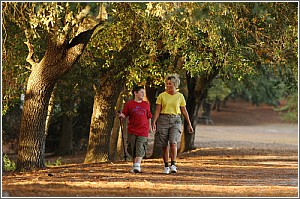2015 Wellbeing May Physical
Physical
May 14th National Dance Like a Chicken Day! Although we may not like to admit it, we all have rocked the Chicken Dance at least once or twice in our lives. This silly dance is a perennial favorite at birthday parties, bat mitzvahs, weddings, and other family gatherings.
A Swiss accordion player named Werner Thomas wrote the melody for the Chicken Dance song in the late 1950s. In 1963, he began performing it at his restaurant. The people who bravely stood up and danced along to the tune often used sporadic movements that reminded Thomas of ducks and chickens. By the time the Chicken Dance arrived in America in the 1970s, it had acquired set choreography with repetitive beak, wing, and tail motions.
Today, the Chicken Dance has earned a permanent place in the pantheon of cheesy party dances. Other favorites include the Hokey Pokey, the Electric Slide, and the Macarena. To celebrate National Dance Like a Chicken Day, turn on this familiar tune and dance like a chicken!
So how do you celebrate this special day? Simple, dance like a chicken! Says it all in the name really and of course you don’t just dance without any music, it has to be the chicken dance song, also known as the Birdie Song.
May 15th IIDA Golf tournament More info here
May 15th is National Bike to Work Day, sponsored by the League of American Bicyclists and celebrated in communities from coast to coast. Established in 1956, National Bike Month is a chance to showcase the many benefits of bicycling and encourage more folks to giving biking a try.
Whether you bike to work or school; ride to save money or time; pump those pedals to preserve your health or the environment; or simply to explore your community, National Bike Month is an opportunity to celebrate the unique power of the bicycle and the many reasons we ride.
May 18th is International Museum Day International Museum Day (IMD) is a celebration that held every year on or around 18 May, coordinated by the International Council of Museums (ICOM). The event highlights a specific theme that changes every year and that is at the heart of the international museum community’s preoccupations.
The International Museum Day provides the opportunity for museum professionals to meet the public and alert them as to the challenges that museums face. Indeed, following the definition of museums provided by ICOM, a museum is a non-profit, permanent institution in the service of society and its development, open to the public, which acquires, conserves, researches, communicates and exhibits the tangible and intangible heritage of humanity and its environment for the purposes of education, study and enjoyment.
International Museum Day therefore serves as a platform to raise public awareness on the role museums play in the development of society today, on an international level.
May 25th National Tap Dance Day falls on May 25 every year and is a celebration of tap dancing as an American art form. The idea of National Tap Dance Day was first presented to U.S. Congress on February 7, 1989 and was signed into American law by President George H.W. Bush on November 8, 1989. The one-time official observance was on May 25, 1989. Tap Dance Day is also celebrated in other countries, particularly Japan, Australia, India and Iceland.
National Tap Dance Day was the brainchild of Carol Vaughn, Nicola Daval, and Linda Christensen. They deemed May 25 appropriate for this holiday because it is the birthday of Bill “Bojangles” Robinson, a significant contributor to tap dance.
Tap dance day can be celebrated with an event which may be organized by a studio or tap dance interest group. Some may also celebrate it individually due to geographical dispersion or lack of access to the wider tap community. National Tap Dance Day is celebrated in many different ways. For example, a studio may send people out onto the streets to teach the “Shim Sham Shimmy” to passers-by. However, there are several cities that have their own performances and events to coincide with Tap Dance Day.
May 30th Walk, Ride, Meet, Eat Stay Tuned For More Information
App: Mind Body Connect This app is for anyone who loves wellness. Whether you want a great workout, a chance to relax, or just to feel beautiful, the perfect place is waiting. Use MINDBODY Connect to find it, book it instantly, and even pay—right from your phone. Once you find a place you love, save it as your favorite, and book your next visit in seconds.
Tens of thousands of businesses use MINDBODY software worldwide, and when you register for MINDBODY Connect you can instantly sync the app with the accounts you have at all of your favorites.
Apple download it here
Android get it here
In aromatherapy, tea tree essential oil is employed for its physical, rather than emotional or aesthetic nature. This isn’t to say that the strongly medicinal aroma of tea tree is offensive. Many appreciate its underlying intensely warm, nutmeg-like scent.
Some of the most effective aromatherapy uses for tea tree oil are cosmetic in nature. For instance, tea tree has a marked oil dissolving and dispersing action, which can help alleviate overly oily secretions of the skin. One way to take advantage of tea tree’s natural astringent action is to dilute 12 drops of the oil in about three ounces of warm water and gently wipe freshly cleaned skin with the mixture using a soft cotton ball.
An oily scalp can also benefit from an application of tea tree. Before shampooing, a gentle massage with a few drops of the oil will gently invigorate the scalp and help lift greasy deposits from the hair shaft.
Because of the mild qualities of tea tree’s terpinen content, the oil can soothe cuts, scratches, sunburn and cold sores. Because it’s non-irritating, a single drop of the oil can be applied directly to minor injuries once or twice a day.
For a soothing sunburn treatment, tea tree is especially effective when paired with lavender oil. Add five drops of tea tree and 11 drops of lavender oil to three ounces of cool, distilled water. Place this mixture in a bottle with a spray atomizer attachment and mist sunburned areas whenever cooling relief is needed.
Other oils that sweeten tea tree’s medicinal aroma include clary sage, geranium and marjoram. Spice oils like nutmeg and cinnamon increase the warm-woody notes of tea tree. This spicy blend is good for wintertime diffusion during the cold and flu season.
Tea tree oil is an important therapeutic and cosmetic essential oil. Despite its less than beautiful fragrance it should figure prominently in any beginner or advanced aromatherapist’s repertoire.
Steelcase Statistic: 2.3 Billion overweight adjust by 2015
#bewellwithus


